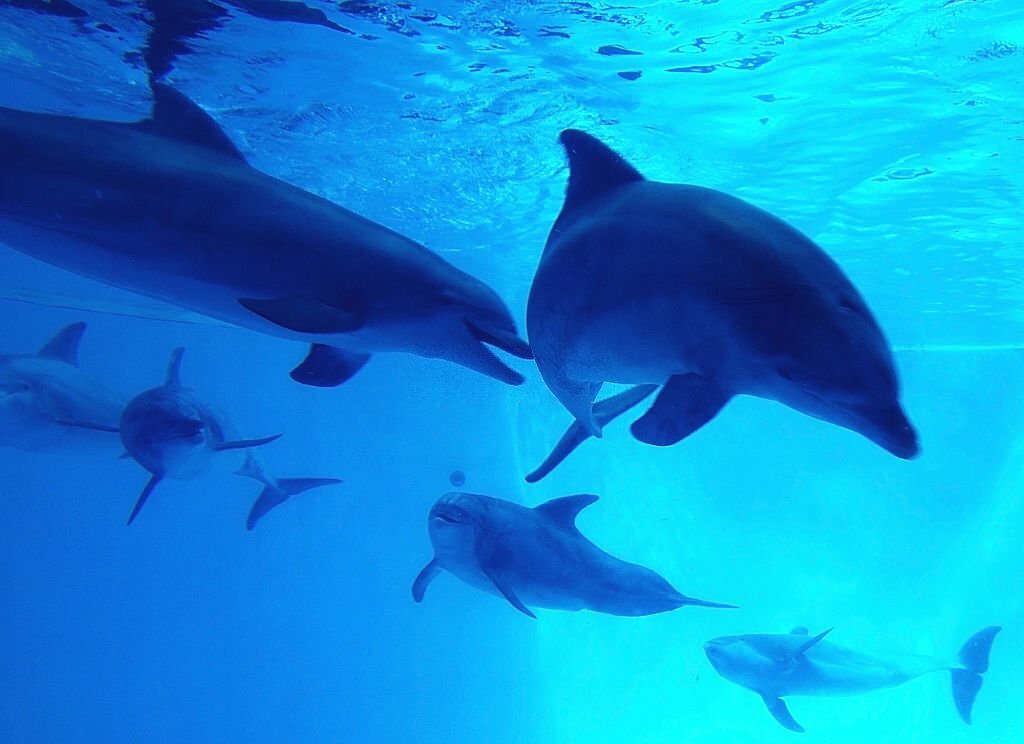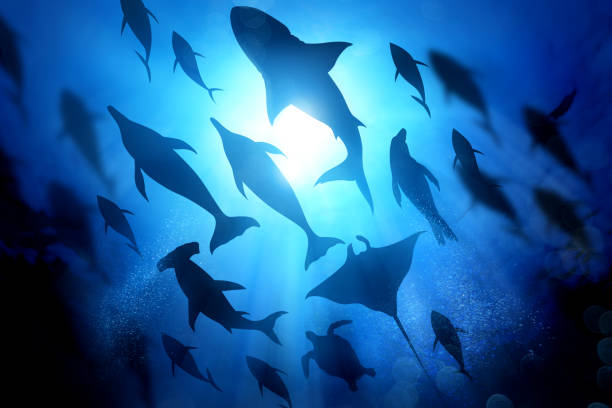
Dolphins, graceful marine mammals known for their playful behavior and superior intelligence.
They are well-known as impressive guardians in their aquatic environment, protecting themselves against potential dangers that threaten it.
This blog post delves into how do dolphins protect themselves, the various defense mechanisms employed by dolphins and their young from threats lurking deep underwater.
Table of Contents
- 1 How Do Dolphins Protect Themselves? Top 10 Survival Tactics
- 1.1 What Are The Defense Mechanisms Of Dolphins?
- 1.2 How Do Dolphins Protect Themselves From Sharks?
- 1.3 How Do Dolphins Protect Themselves From Predators?
- 1.4 How Do Dolphins Defend Themselves From Danger?
- 1.5 How Do Bottlenose Dolphins Protect Themselves?
- 1.6 How Do Hector Dolphins Protect Themselves?
- 1.7 How Do Spinner Dolphins Protect Themselves?
- 1.8 How Do Amazon River Dolphins Protect Themselves?
- 1.9 How Do Striped River Dolphins Protect Themselves?
- 1.10 How Do Dolphins Protect Their Young?
- 2 How Do Fish Protect Themselves From Dolphins?
- 3 Frequently Asked Questions (FAQs)
- 4 Conclusion: How Do Dolphins Protect Themselves
How Do Dolphins Protect Themselves? Top 10 Survival Tactics
Dolphins have several ways to protect themselves in their natural environment. Here are top 10 survival tactics:
1. Strength in Numbers
Dolphins travel in groups known as pods for increased protection. Being together makes it harder for predators to target an individual dolphin.
2. Speed and Agility
Dolphins are fast swimmers that can reach speeds of 60 km/h (37 mph). Their agility and speed allow them to easily escape predators.
3. Echolocation
Dolphins use echolocation, an echolocator sonar, to navigate and detect objects in their environment, which helps them identify prey as well as avoid possible threats in their environment. This method assists dolphins with finding food while simultaneously protecting against danger.
4. Communication
Dolphins are social animals who communicate via clicks, whistles and body movements with one another to avoid potential danger. Effective communication within their pod helps alert individuals of imminent risks or danger.
5. Intelligence
Dolphins are widely recognized for their high level of intelligence. Their swift learning ability enables them to quickly adapt and respond appropriately when facing threats or opportunities.
6. Camouflage
Dolphins utilize natural countershading camouflage. Their back is darker than their belly, making it harder for predators to spot them from above or below in the water.
7. Playful Behaviors of Dolphins
While dolphins’ seemingly playful behaviors such as surfing waves or riding bow waves of boats may appear playful at first, such as surfing on waves or riding them can serve a much larger purpose.
It discourages potential threats by showing vitality and strength – and deterring predators who would pose as potential prey targets by signaling to them that these strong individuals should not be easy targets for predation.
8. Protective Parental Behaviors
Mother dolphins exhibit strong maternal care towards their calves. They keep close and teach essential survival techniques that increase chances of their success in survival.
9. Collaborative Hunting
Dolphins often work cooperatively when hunting, creating a coordinated effort that makes catching prey easier while discouraging potential threats.
10. Use of Tools
Although less frequently seen among other intelligent animals, dolphins have been reported using sponges to shield their rostrums (snouts) while foraging on the seafloor – an example of problem-solving abilities and tool usage.

What Are The Defense Mechanisms Of Dolphins?
Dolphins possess several mechanisms for protection from potential predators, including:
Social Behaviors: Dolphins are social animals who form pods for safety against predators; pod sizes range from several individuals up to over one hundred dolphins.
Their interaction provides various advantages; one being protection from attack by predators who would likely target an isolated dolphin more likely than one living alone in its pod.
Echolocation: Dolphins use echolocation not only to navigate and find food, but they can also use it to detect predators.
Echolocation allows dolphins to create three-dimensional maps of their environment even under low or no light conditions, giving them a significant edge against predators who rely solely on sight for detection.
Speed and Agility: Dolphins are extremely fast swimmers that can reach speeds up to 35 miles per hour while changing direction swiftly – this makes it hard for predators to catch them!
Intelligence: Dolphins are intelligent animals capable of working together to defend against potential threats to themselves, such as predators.
For instance, dolphins may surround an aggressor and use their echolocation capabilities to disorient him/her before striking again with physical aggression.
How Do Dolphins Protect Themselves From Sharks?
Dolphins employ various strategies to defend themselves against sharks, using their remarkable speed and agility to outswim most species of sharks.
Traveling together as pods creates a united front against potential threats while disorienting and discouraging any shark attacks.
Dolphins use echolocation to detect sharks at distance, using their sharp rostrums as defense mechanisms against any possible attacks from sharks.
Effective communication within pods enables responses to be coordinated more quickly while intelligence allows dolphins to learn from encounters while avoiding shark-prone areas; all these strategies help increase dolphin protection against attacks by sharks.
How Do Dolphins Protect Themselves From Predators?
Dolphins use several defense mechanisms to safeguard themselves from predators.
Their pod travel together, giving strength in numbers and cooperative defense; additionally, their remarkable speed and agility help elude threats that might threaten them.
Dolphins use echolocation to detect predators from a distance and possess sharp teeth and strong jaws to deter attackers.
Communication amongst their pod allows for coordinated responses effectively while their intelligence allows them to learn and adapt accordingly, thus avoiding dangerous situations altogether.
Dolphins, with their strong social bonds and adaptability, have proven adept at protecting themselves against marine predators.
See Also: What Are Dolphins Scared Of? Unseen Dangers
How Do Dolphins Defend Themselves From Danger?
Dolphins have developed numerous defense mechanisms to safeguard themselves in the ocean environment, drawing upon their unparalleled speed and agility to quickly evade threats and stay safe.
Dolphin pods travel together for increased strength. Echolocation helps detect predators and obstacles; sharp teeth help deter attackers. Clear communication within each pod enables coordinated responses to threats.
Dolphins possess intelligent minds which enable them to learn from experience, thus avoiding potentially risky situations.
Combining all their talents, dolphins are adept at protecting themselves in marine environments from dangers such as sharks.

How Do Bottlenose Dolphins Protect Themselves?
Bottlenose dolphins protect themselves by living in groups, using echolocation to detect predators, and swimming quickly and agily to avoid being hunted down by them.
Working as one, they can work together against an attacker by surrounding it or disorienting it using echolocation technology.
How Do Hector Dolphins Protect Themselves?
Hector’s dolphins, one of the smallest and rarest species of dolphin, use various strategies to protect themselves in their marine environment:
Intelligence: Hector’s dolphins boast exceptional intelligence that allows them to adapt easily to changing circumstances and avoid potential dangers.
Vigilance: Hector’s dolphins are highly aware and conscious of their surroundings, often showing behaviors indicating alertness so as to quickly react and respond when threatened by potential dangers.
Avoidance Behaviors: They generally avoid places with threats present to reduce their chance of encountering predators.
Protective Parental Behaviors: Mother dolphins exhibit protective parental behavior toward their calves by staying close by them and teaching essential survival techniques, increasing the odds that their calves survive.
Avoid Human Interaction: Hector’s dolphins are particularly at risk from human activities like fishing nets and boat traffic; therefore their survival hinges upon being protected from these potential human-caused threats.
How Do Spinner Dolphins Protect Themselves?
Spinner dolphins use speed, agility and acrobatic skills to defend against predators by travelling in large pods that use strength in numbers.
Their echolocation enables navigation and threat detection while communication within their pod enables coordinated defense strategies; their intelligence and social bonds further increase their ability to avoid danger.
How Do Amazon River Dolphins Protect Themselves?
Amazon River dolphins (commonly referred to as pink river dolphins) use echolocation as an effective defense mechanism.
Echolocation helps these aquatic mammals navigate and detect threats in murky Amazon River waters and ensures their own protection.
How Do Striped River Dolphins Protect Themselves?
Striped river dolphins, found throughout Asia and South America, rely on agility and social structure for protection from predators.
As they travel in groups, it becomes much harder for predators to pinpoint an individual for attack by predators.

How Do Dolphins Protect Their Young?
Dolphin mothers protect their young in various ways. For instance:
Stay Close: Dolphin mothers remain close to their calves during the early months after birth in order to protect them from predators or any potential risks. This helps shield their offspring against threats like predatory fishes.
Social Behavior: Dolphins live in groups known as pods, which work collectively to protect their young from threats such as predators.
For instance, pods might encase a newborn calf to shield it from harm from potential threats like sea mammals.
Echolocation: Dolphins utilize echolocation as a method for communicating and sensing their environment, helping them keep track of their calves as well as warn of impending danger.
This allows them to stay aware of threats before it happens!
Intelligence: Dolphins are highly intelligent animals capable of teaching their young essential survival skills such as finding food, avoiding predators and navigating their environment.
How Do Fish Protect Themselves From Dolphins?
Fish have numerous ways of protecting themselves against dolphins, such as:
Forming Schools: Dolphins have difficulty attacking schools of fish. Since these individuals constantly move and change direction, it makes it more challenging for dolphins to focus their attacks on one individual fish at once.
Camouflage: Fish that have camouflage to blend in with their surroundings are difficult for dolphins to detect in murky water environments, making camouflage even harder for dolphins to spot.
Spines and Venom: Some fish possess spines or venom to deter dolphins from attacking them, like pufferfish that inflate to cover themselves with sharp spines – potentially dangerous food sources that must be eaten.
Speed and Agility: Certain species of fish have the ability to swim very rapidly and quickly, which makes it harder for dolphins to catch them. Tuna are particularly fast swimmers – reaching speeds up to 40 miles per hour in its pursuit.
Hiding: Fish that need protection from dolphins often seek refuge within reefs, crevices or other structures to evade capture by dolphins.
Frequently Asked Questions (FAQs)
How Do Dolphins Protect Themselves In The Ocean?
Dolphins defend themselves through speed, agility, echolocation, social bonds and communication in pods to effectively avoid threats in their ocean environment.
How Do Dolphins Protect Themselves Out Of Water?
Due to their need for breathing air and body temperature regulation, dolphins cannot survive out of water for extended periods. Land protection methods therefore become irrelevant to them.
How Do Dolphins Protect Themselves Naturally?
Dolphins protect themselves naturally through speed, agility, echolocation, teamwork, communication and social bonds that help evade predators while efficiently navigating marine environments. These adaptations enable dolphins to avoid predation.
Conclusion: How Do Dolphins Protect Themselves
Dolphins have evolved an arsenal of defense mechanisms in order to survive and flourish in the ocean environment.
Their amazing ability to protect themselves against various threats showcases both nature’s brilliance and this amazing marine mammals’ ingenuity.
As we study and appreciate these magnificent animals, it is crucial that we respect their natural environment and help conserve ocean ecosystems where they reside.

Mr. Das, a certified pharmaceutical scientist, holds a Bachelor of Science in Pharmaceutical Sciences and passionately contributes to dolphin conservation as a member of the committee in Bangladesh.


